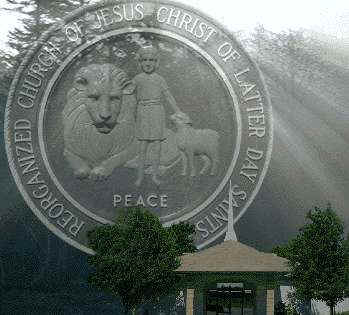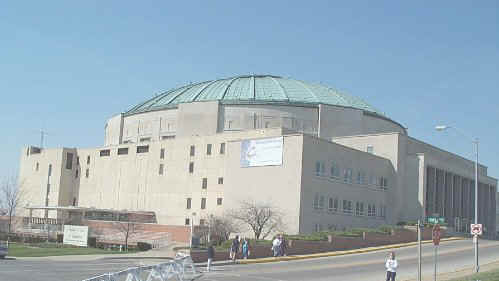
Home Page
Herbert Armstrong
Columns
Ambassador Watch
Site Guide
Links
|
|
|||||
|
Home Page |
Herbert Armstrong |
Columns |
Ambassador Watch |
Site Guide |
Links |
|
Southern Exposure |
|
Gavin Rumney |
In the 1970s there was a church that proudly displayed a seal bearing the image of a small child, a lamb and a lion. A church that had built an extravagant auditorium to hold services in, and serve as a cultural center for the surrounding community. This same church ran its own liberal arts college. And it was moving in new directions theologically, raising accusations of "liberalism" from some quarters.

An earlier version of the RLDS seal superimposed behind the church's Modesto, California chapel.
That body was the Reorganized Church of Jesus Christ of Latter Day Saints.
Now known as The Community of Christ, this group, headquartered in Independence, Missouri, is the second largest Mormon denomination after the Utah-based LDS church. It has a membership worldwide of some 250,000.
Setting the Scene.
The Worldwide Church of God is a member of the Adventist family of religious groups, separating in the 1930s from the Church of God (Seventh Day). Originally known as the Radio Church of God it quickly became a distinct sect in its own right. The founder, Herbert W. Armstrong, was happy to adopt "truth" from a variety of sources. Is it possible that his borrowings included some from the "Restoration movement" established nearly a century before by Joseph Smith Jr.? And is it possible that there might have been substantial interchange between certain Mormon sects and the Church of God (Seventh Day) prior to Armstrong's separation?
One qualification before proceeding. The term "Mormon" as it is used here does not refer exclusively, or even primarily, to the church headquartered in Salt Lake City. The "restoration movement" has a number of strands, and it is among some of the smaller bodies that interesting convergences with the WCG appear.
WCG pre-history: The Mid-West Connection.
The roots of the WCG lie not in California, but in the American Mid-West. In the 1930s the Church of God (Seventh Day) was headquartered in Missouri. It was here that independent Adventist congregations had rejected the authority of Ellen White (Seventh-day Adventism's prophetess) and coalesced into a denomination. It was also here that another American prophet, Joseph Smith, discovered his "Zion", designating the town of Independence, Missouri as the "Center Place." Smith believed that the original site of the Garden of Eden was to be found in Missouri, and prophesied that when Christ returned, it would be to a temple standing on the Temple Lot in the town of Independence.
Long after Brigham Young led the great trek to Utah, the Mid-West was to continue as the heartland for a less extreme version of Mormonism. Those that rejected Young's iron rule forged a new body, the Reorganized Church of Jesus Christ of Latter Day Saints. It was to this group that Joseph Smith's immediate family rallied, including his widow Emma and sons. In due course Smith's eldest son, Joseph III, ascended to the church presidency. The younger Smith distanced the church from the controversial Utah body, denouncing polygamy and rejecting the temple rituals practiced in the larger sect.
A much smaller schism formed among the early Latter Day Saints when a number of believers fell under the influence of James Strang. It is among the Strangites and RLDS that some surprising WCG connections may be found.

RLDS Auditorium, completed in the 1950s
The Church Organization Debate.
Those familiar with Herbert Armstrong's autobiography will recollect that the parent body of the Church of God (Seventh Day) split apart over the issue of the correct form of church organization. A dissident group, led by the colorful Andrew Dugger, promulgated a "Bible organization" plan with Apostles (of which there were to be twelve) at the top of a ministerial hierarchy. This presumably would follow the New Testament precedent.
What few writers have noticed, however, is how closely the Dugger doctrine resembled that of the various Mormon sects that were active at that time, and working the same territory in direct competition with the Church of God. These were times of public debates between different Christian groups. A favorite subject was the Sabbath question, and the meetings were a form of entertainment in a time before TV chat shows or talk radio. It was an essential principle of the "Restoration" that the apostolic offices were to be re-established, and that this constituted proof of Mormonism's legitimacy. Both the Utah and Independence bodies have 12 Apostles and lesser offices such as "seventies". Dugger duplicated this. And it would be surprising if there was not interaction, debate and exchange of beliefs between these two very American religious movements, both of which were vigorously promoting themselves. So it seems likely that the Dugger faction lifted the concept of "Bible organization" directly from one of the Restoration sects (probably the RLDS.) And, as we shall see shortly, the Strangites may have borrowed heavily from an Adventist body such as the Church of God.
Armstrong himself later rejected the Dugger innovation (twelve apostles was apparently eleven too many!) However the system of "evangelists" that he later set up was to mimic the Mormon system in some ways.

James Strang
The Sabbath and the Strangites.
Herbert Armstrong borrowed from a wide variety of sources as he cobbled together the unique blend of doctrines and customs that once characterized the Worldwide Church of God. Any uniqueness was however in the blending, and not in the constituent parts, each of which had precedents. For example his key work, The United States and Britain in Prophecy, was a plagiarized rehash of Judah's Sceptre and Joseph's Birthright by J. H. Allen, a British-Israel advocate from the early 1900s.
Armstrong was not alone in his promiscuous use of other people's pet theories. James Strang, an early schismatic Mormon leader, was similarly disposed. Falling out with both Brigham Young and the Reorganization, Strang founded a Seventh Day Mormon sect after becoming convinced that the Sabbatarians (the independent Adventists of the Church of God?) had it right.
A current statement from these innovative Latter Day Saints reads:
We believe in the Ten Commandments, including the commandment to "Remember the Sabbath day ... the seventh day is the Sabbath of the Lord thy God," which God gave as a "perpetual" memorial. James J. Strang restored that commandment in 1850 as part of the "Restoration" of all things.
Strang also speculated on the Old Testament sacrificial system, and the Old Testament law. While it seems unlikely that Armstrong borrowed directly from the Strangites (who now prefer to be known as Great Lakes Mormons) he would certainly have known of them. This takes on added significance when the origins of the God Family doctrine are considered; long considered to have much in common with the Mormon understanding of the Godhead. Could Armstrong have flinched his "anthropomorphic" doctrine (that God has a spiritual body, complete with body parts) from James Strang's Mormon cult? And what about the now abandoned teaching that "the incredible human potential" is to "become God as God is God." Both resonate with Joseph Smith's doctrines.
(The RLDS tradition has abandoned the plurality of God teachings and now holds a position much closer to mainstream Christianity.)
Later Cross Pollination.
For those who were members of the WCG during the 1970s and 80s the church was characterized by more than just distinctive doctrines. We shunned the use of the cross as a symbol (as did the Mormon sects.) Instead there was wide use of "The Peaceable Kingdom" motif from Isaiah: a lion, a lamb and a small child (as with the RLDS.) These symbols were adopted on the church's seal (as with the RLDS.) And then there was an extravagant auditorium that served as a focus for the church (as with the RLDS.) Then there was the church's Ambassador College, supposedly a liberal arts institution (and yes, the RLDS had one of those too, Graceland College, so named long before Elvis strummed his first guitar chord.)

Present Community of Christ seal
Even the period of "liberalism" - a brief Indian Summer of relative sanity in the late seventies (often associated with the Systematic Theology Project) - was prefigured in a reform movement within the RLDS church that began in the sixties. By the seventies the Reorganized Mormons had already made a transition from the far fringes of Christianity toward the moderate mainstream.
The RLDS transition, although painful to many members and leading to some decline in numbers, was less frenzied and destructive than the reforms that later shattered the WCG when the ham-fisted Tkach administration decided to return to a reforming agenda. The RLDS church has been careful to pace its reforms, and retain key elements of its distinctive history and culture.
It is interesting to note that WCG apostle-in-waiting Garner Ted Armstrong was very familiar with the Reorganized Mormons. He has related how, in the early years of his ministry he had RLDS neighbors which he "compared notes" with. And one of his closest ministerial hunting buddies was raised in the RLDS church before converting to Armstrongism.
Imitation is said to be the sincerest form of flattery. Could it be that the Reorganization copied Worldwide rather than the reverse? The RLDS seal dates back well before the WCG's adoption of the symbols - it has undergone many redesigns over the decades, but all recognizably based on the Peaceable Kingdom. The RLDS auditorium was envisioned in the 1920s and completed in the 1950s. Graceland College (now Graceland University) has been around since 1895. In every case it was the WCG which seems to have appropriated the older church's distinctive traits. It seems almost as though the Reorganization may have served as some kind of template for the WCG at certain times in its history. Perhaps a past generation of WCG leaders saw the Reorganization as, at the time, a successful example of a sect making the transition to respectability and stability.
RLDS scholar Wayne Ham, in an essay discussing the more obscure Mormon schisms, recounts one example of "contamination" between the two groupings, Mormonism and the Church of God: Then there's Doug Boyd, a self-proclaimed prophet, who was reared on a diet of Worldwide Church of God ideas, so he celebrates all of the Jewish holy days. He comes to town [i.e. Independence, Missouri] for every major Jewish festival to stand on the Temple Lot and proclaim his prophecies.
(Wayne Ham. Center Place Saints. Published in Restoration Studies III, Herald House 1986)
Conclusion
No man is an island. Nor, apparently, is a sect. It seems that the Mormon and Church of God traditions have been influencing one another in the American Mid-West for a very long time. And it may also be that, at some stages in the WCG's history, there was some conscious modeling on the Reorganized Church. It seems somehow fitting that, with the crumbling of Armstrongism and the shedding of its one-time distinctives, that the Reorganization seems to be left in sole possession of those things that were originally theirs.
Today the RLDS church has completed a new step in its journey. It is now known as the Community of Christ. For many years the Presidency of the church was reserved for direct descendants of Joseph Smith. Its current president has no such lineage. Many Community of Christ congregations seem similar to mainstream Christian churches. The Book of Mormon has been de-emphasized, and many church members regard it as uninspired. The church ordains women and in its Lord's Supper observance practices open communion. Its leadership is regarded as more liberal than evangelical (most of the fundamentalists have left.) Like the WCG it is a fascinating study in the sociology of religion.